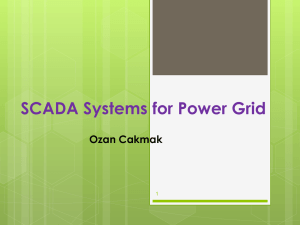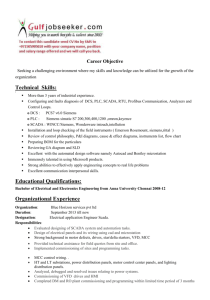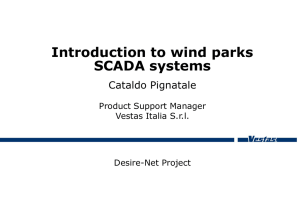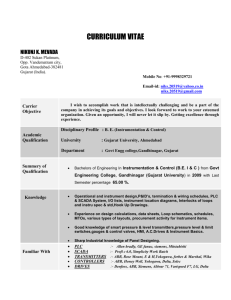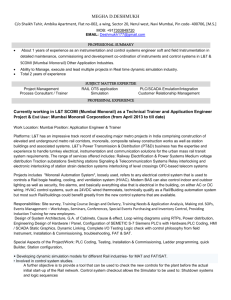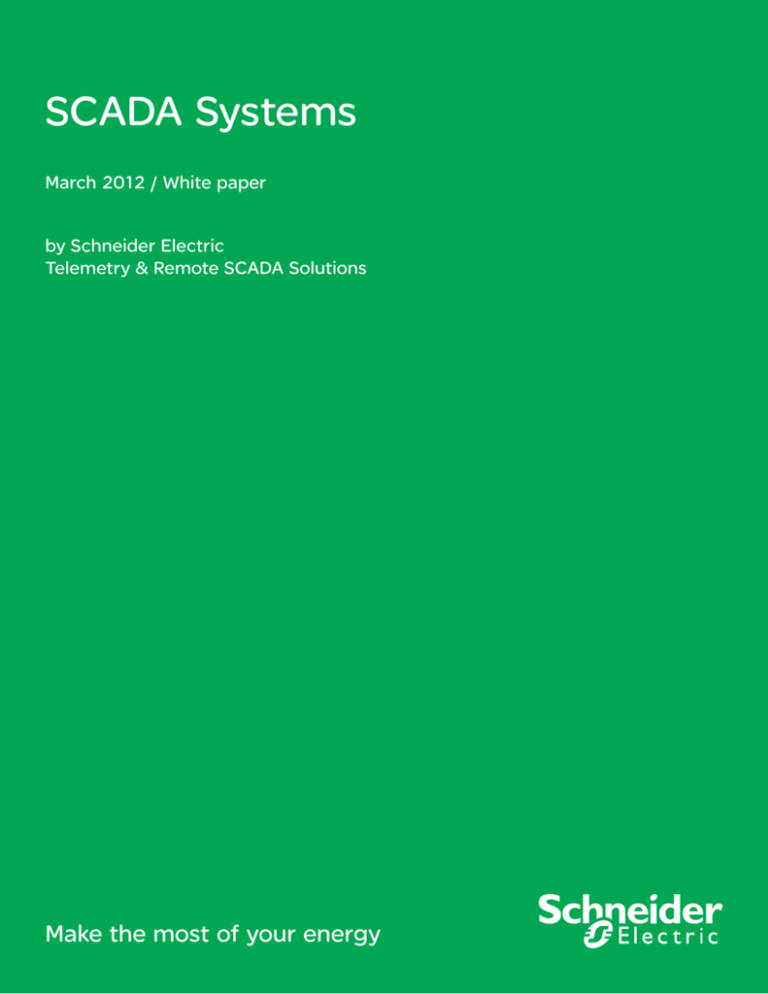
SCADA Systems
March 2012 / White paper
by Schneider Electric
Telemetry & Remote SCADA Solutions
Make the most of your energy
Summary
Executive Summary ......................................................................................... p 2
Introduction ..................................................................................................... p 3
Field Instrumentation ........................................................................................ p 4
PLCs and RTUs ............................................................................................... p 5
Remote Communications Networks ................................................................. p 6
SCADA Host Software ..................................................................................... p 8
Security ........................................................................................................... p10
Conclusion ...................................................................................................... p11
SCADA Systems Overview
Executive summary
This white paper discusses the various components found in a typical Remote
SCADA System, the operational challenges inherent in these types of systems,
and how various technological advances have been implemented to drive
forward SCADA System proficiency.
White paper on SCADA Systems Overview | 02
SCADA Systems Overview
Introduction
The definition of SCADA is ‘Supervisory Control and Data Acquisition’. The
major function of SCADA is for acquiring data from remote devices such as
valves, pumps, transmitters etc. and providing overall control remotely from a
SCADA Host software platform. This provides process control locally so that
these devices turn on and off at the right time, supporting your control strategy
and a remote method of capturing data and events (alarms) for monitoring these
processes. SCADA Host platforms also provide functions for graphical displays,
alarming, trending and historical storage of data.
Historically, SCADA products have been produced that are generic with a ‘one
shoe fits all’ approach to various markets. As SCADA has matured to provide
specific solutions to specific SCADA markets it has provided solutions for wide
area network SCADA systems that rely on tenuous communication links. These
types of SCADA systems are used extensively throughout the Oil & Gas market
due to the fact that assets are spread over large geographical areas.
Looking at the overall structure of a SCADA system, there are four distinct levels
within SCADA, these being;
i. Field instrumentation,
ii. PLCs and / or RTUs,
iii. Communications networks and
iv. SCADA host software.
We will discuss each of these levels in detail, describing their function, how
SCADA has changed over the past 30 years and the impact of security
requirements and regulatory compliance on SCADA system operations.
Field
Instrumentation
PLCs / RTUs
Comms /
Telemetry
SCADA Host
Ethernet
Radio
Serial
Dial-up
Figure 1:
SCADA System Overview
White paper on SCADA Systems Overview | 03
SCADA Systems Overview
Field Instrumentation
“You can’t control what you don’t measure” is an old adage, meaning that
instrumentation is a key component of a safe and optimised control system.
Traditionally, pumps and their corresponding operational values would have been
manually controlled i.e. an operator would start/stop pumps locally and valves
would have been opened/closed by hand. Slowly over time, these instruments
would have been fitted with feedback sensors, such as limit switches, providing
connectivity for these wired devices into a local PLC or RTU, to relay data to the
SCADA host software.
Early
instrumentation
Feedback sensors
Add Actuators
Pro
Installation
is cost-effective
Central view
Central control
Con
Expensive
to operate
Still expensive
to operate
Higher technical
requirements
Figure 2:
Progress of Instrumentation
Although today’s instrumentation technician requires more technical knowledge
and the ability to design, install and maintain equipment, than in the past, this
is mitigated by the reduced cost in automating processes and higher technical
skills held by personnel. Today, most field devices such as valves have been
fitted with actuators, enabling a PLC or RTU to control the device rather than
relying on manual manipulation. This capability means the control system can
react more quickly to optimise production or shutdown under abnormal events.
In terms of regulatory compliance, instrumentation for the oil & gas industry has
had to comply with hazardous class, division and group classifications. The
requirement is that the instrument must be designed for the location or area in
which it has been placed, eg. an environment where the existence of explosive
vapours during normal operating conditions, or during abnormal conditions, are
known.
In many cases the instrument is also required to function in harsh environments.
Many types of instrumentation are designed for extremes of hot and cold. If the
instrumentation is not designed for these temperatures, an artificial environment
within a cabinet or some sort of building is required. This comes at an extra cost
not just in initial design but also for ongoing maintenance.
Instrumentation must also comply with any EMC (electromagnetic compatibility)
standards which may be in place, to ensure that an electrical device does not
have any undesirable effects upon its environment or other electrical devices
within its environment.
White paper on SCADA Systems Overview | 04
SCADA Systems Overview
PLCs and RTUs
Programmable Logic Controllers (PLCs) and Remote Telemetry Units (RTUs)
used to be distinctly different devices but over time they are now almost the
same. This has been a convergence of technology as manufacturers of these
devices expanded their capabilities to meet market demands.
If we go back 30 years, an RTU was a ‘dumb’ telemetry box for connecting field
instruments. The RTU would ‘relay’ the data from the instruments to the SCADA
host without any processing or control but had well-developed communication
interfaces or telemetry. In the 1990s control programming was added to the
RTU so it operated more like a PLC. PLCs on the other hand could always do
the control program but lacked communication interfaces and data logging
capability, which has been added to some extent over the past decade.
A further development of devices in the field is to offer a specific application
that could incorporate a number of instruments and devices with an RTU/
PLC, incorporating technology sets to provide an ‘off the shelf’ approach to
common process requirements, e.g. gas well production that includes elements
of monitoring, flow measurement and control that would extend as an asset into
the SCADA Host.
In terms of environmental and regulatory compliance, PLCs and RTUs have the
same type of requirements as instrumentation in that they operate in the same
environment. However, PLCs have traditionally not been as environmentally
compliant as RTUs. This is mainly due to the fact that PLCs were designed to
operate in areas, such as factory floors, where the environment was already
conditioned to some degree.
White paper on SCADA Systems Overview | 05
SCADA Systems Overview
Remote Communications Networks
The remote communication network is necessary to relay data from remote
RTU/PLCs, which are out in the field or along the pipeline, to the SCADA host
located at the field office or central control center. With assets distributed over
a large geographical area, communication is the glue or the linking part of a
SCADA system and essential to its operation. How well a SCADA system can
manage communication to remote assets is fundamental to how successful the
SCADA system is.
Twenty years ago the communication network would have been leased lines or
dial-up modems which were very expensive to install and maintain, but in the
last 10-15 years many users have switched to radio or satellite communications
to reduce costs and eliminate the problematic cabling issues. More recently,
other communication types have been made available that include cellular
communications and improved radio devices that can support greater
communication rates and better diagnostics. However, the fact that these types
of communication media are still prone to failure is a major issue for modern,
distributed SCADA systems.
At the same time as the communication medium changed so too did the
protocols. Protocols are electronic languages that PLCs and RTUs use to
exchange data, either with other PLCs and RTUs or SCADA Host platforms.
Traditionally, protocols have been proprietary and the product of a single
manufacturer. As a further development, many manufacturers gravitated to a
single protocol, MODBUS, but added on proprietary elements to meet specific
functionality requirements. For the Oil & Gas industry there are a number of
variants of MODBUS, including but not limited to, MODBUS ASCII, MODBUS
RTU, Enron MODBUS and MODBUS/TCP. This provided a communication
standard for the retrieval of flow or process data from a particular RTU or PLC.
This incremental development in using MODBUS protocol variants was seen
as an improvement, but it still tied a customer to a particular manufacturer,
which is very much the case today. A good example is how historical flow data
is retrieved from a RTU/PLC by a SCADA Host. However, the advancement of
SCADA Host software, and in some cases the sharing of protocol languages,
has meant that many of the issues with proprietary elements have been further
resolved.
White paper on SCADA Systems Overview | 06
SCADA Systems Overview
In recent years, protocols have appeared that are truly non-proprietary, such
as DNP (Distributed Network Protocol). These protocols have been created
independently of any single manufacturer and are more of an industry standard;
many individuals and manufacturers have subscribed to these protocols and
contributed to their development. However, these protocols have yet to develop
significantly enough to have a broad appeal to the application process and
regulation requirements for oil & gas markets. Consequently, the oil and gas
market is still heavily invested in MODBUS variants. As the benefits of these
protocols become more apparent to users, it is expected that they will be more
readily accepted and become a component of standard solutions provided
specifically for oil and gas markets.
Comms /
Telemetry
PLCs / RTUs
FED / FEP
SCADA Host
Ethernet
Radio
Serial
Dial-up
Communications are
prone to failure. Causes
loss of data and loss of
visibility. Protocols like DNP
mitigate this.
These are now
a software element
in SCADA Host.
Figure 3:
Wide Area Network SCADA
White paper on SCADA Systems Overview | 07
SCADA Systems Overview
SCADA Host Software
Traditionally, SCADA Host software has been the mechanism to view graphical
displays, alarms and trends. Control from the SCADA Host itself only became
available when control elements for remote instruments were developed.These
systems were isolated from the outside world and were the domain of operators,
technicians and engineers. Their responsibility was to monitor, maintain and
engineer processes and SCADA elements. With advancements in Information
Technology (IT) this is no longer the case. Many different stake holders now
require real time access to the data that the SCADA Host software generates.
Accounting, maintenance management and material purchasing requirements
are preformed or partly preformed from data derived from the SCADA system.
Consequently, there is a drive for the SCADA Host to be an Enterprise
entity providing data to a number of different users and processes. This has
encouraged SCADA Host software development to adopt standards and
mechanisms to support interfacing to these systems. It also means that IT,
traditionally separated from SCADA systems, is now involved in helping to
maintain networks, database interfacing and user access to data.
Many of the initial SCADA Host products were developed specifically for the
manufacturing environment where a SCADA system resided within a single
building or complex, and did not posses many of the telemetry communication
features required by SCADA systems for geographically distributed assets.
Remote client
ACCESS
Third Party
Database
Include:
• communications drivers
• real-time database
• alarm and event journal
• historic archive
• configuration database
SCADA Host
Platform
Data from field
Figure 4:
SCADA Host Platform
White paper on SCADA Systems Overview | 08
SCADA Systems Overview
These types of 1st-generation SCADA Hosts often required a hybrid PLC or
RTU, called a Front End Driver (FED) or Front End Processor (FEP), to be used
for handling communications with remote devices. This resulted in a number of
disadvantages as it required specialised programming, external to the SCADA
Host platform, and created a communications bottleneck. Although multiple FED
or FEP devices resolved some of this, there were extra costs and difficulties in
creating and maintaining them due to their specialised nature. Modern SCADA
software that encapsulates telemetry functionality no longer requires these types
of hybrid PLCs for communications. They now use software programs called
‘drivers’ that are integrated into the SCADA Host itself. Software drivers contain
the different types of protocols to communicate with remote devices such as
RTUs and PLCs.
As technology developed, SCADA Host software platforms were able to take
advantage of many new features. These included the development of integral
databases specifically designed for SCADA Host software requirements, being
able to handle thousands of changes a second, for really large systems, yet still
conform to standard database interfacing such as Open Database Connectivity
(ODBC) and Object linking and Embedding for Databases (OLE DB). These
standards are required so that third-party databases can access data from the
SCADA Host software. Remote client access to the SCADA Host is another
technology that has enabled users to operate and monitor SCADA systems
while on the move between or at other locations.
There is a drive towards operational safety for SCADA Host systems within the
oil and gas industry. 49 CFR 195.446 Control Room Management regulations
look at SCADA Host software and how it functions in terms of operations,
maintenance and management. It also covers the degree of integration of the
SCADA system itself and its use of open architecture and standards.
White paper on SCADA Systems Overview | 9
SCADA Systems Overview
Security
Security for SCADA systems has in recent years become an important and hotly
debated topic. Traditionally SCADA systems were isolated entities that were
the realm of operators, engineers and technicians. This has meant that SCADA
Host platforms were not necessarily developed to have protected connections
to public networks. This left many SCADA host platforms open to attack as they
did not have the tools necessary to protect themselves.
In terms of remote assets communicating back to a SCADA Host, security has
been an issue for many years with numerous documented attacks on SCADA
systems. However, it’s only been in recent years that an open standard has
been produced to provide secure encrypted and authenticated data exchanges
between remote assets and a SCADA Host platform.
Solutions for remote asset and SCADA host communication security have very
different requirements. Security has to also be viewed overall, and not just in
terms of the SCADA system itself. For example, if somebody wanted to disrupt
production, they would not necessarily need to access the SCADA system to
do this. If a gas wellhead site or a monitoring point on a gas pipeline is remotely
situated, it could be easily compromised by a trespasser. If the asset is critically
important, other solutions that may or may not form part of the SCADA system
itself would have to be considered. e.g. camera surveillance security.
A large number of unauthorised accesses to a SCADA system come not from
or at the remote assets themselves but through the SCADA Host or computers
used to access the SCADA system for diagnostic or maintenance purposes. For
example, the recent attack using the Stuxnet virus was introduced via a thumb
drive on a computer used to access a SCADA system.
There are a number of standards available that describe how to secure a SCADA
system, not just in terms of the technology employed, but in terms of practices
and procedures. This is very important since the security solution to SCADA
is not a technological silver bullet, but a series of practices and procedures
in conjunction with technological solutions. These practices and procedures
would include items of training, SCADA Host access and procedures to follow
when SCADA security has been compromised. In modern SCADA systems IT
departments are integral to implementing and maintaining SCADA security for
an organisation and should be included in setting up practices, procedures and
implementing technologies.
White paper on SCADA Systems Overview | 10
SCADA Systems Overview
Conclusion
From the introduction of actuators and transducers (that made monitoring of
processes easier, more accurate and less costly) at the instrumentation level
to the introduction of open standards (to improve the interchange of data
between a SCADA system and other processes within an organisation), SCADA
systems have exploited the various technological advances to drive forward their
proficiency.
The drive of modern SCADA systems is to:
• Provide instrumentation and RTUs/PLCs for asset or process solutions
that can be easily managed and to provide operational benefits from the
SCADA host down to the instrumentation, not just in terms of controlling and
retrieving data but also engineering, implementing, operating and maintaining
these assets.
• Develop and employ open standards to further ease the integration of assets
within a SCADA system using best practices defined by open groups and
not a single manufacturing entity. This will in turn reduce the cost of owning
SCADA.
• Provide secure environments for SCADA systems and the assets or
processes by not only providing technology solutions but by implementing a
series of practices and procedures.
White paper on SCADA Systems Overview | 11
© 2011 Schneider Electric. All rights reserved.
Schneider Electric
Telemetry & Remote SCADA Solutions
48 Steacie Drive, Kanata, Ontario K2K 2A9 Canada
Direct Worldwide: 1 (613) 591-1943
Fax: 1 (613) 591-1022
Toll Free within North America: 1 (888) 267-2232
www.schneider-electric.com
Document Number TBUL00001-31
This document has been
printed on recycled paper
March 2012
tk


